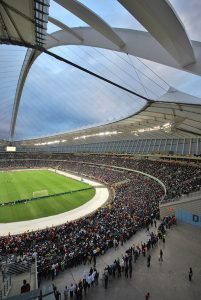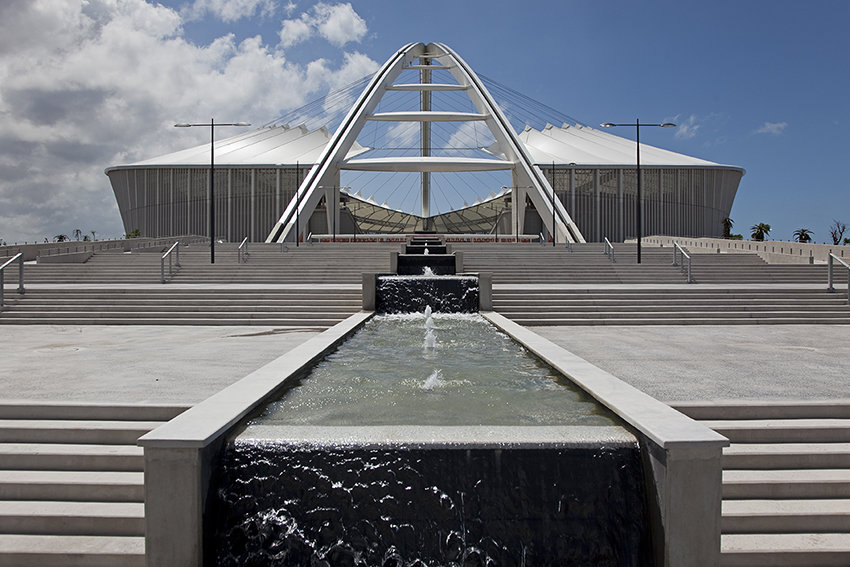Testing, testing, 1, 2, 3
New stadia should have long-term use designed in from the start to ensure success, says engineer and experienced stadium project manager Alf Oschatz. And properly programmed test events will help make sure everything goes to plan for the years to follow.
No one would doubt that major sports events like the Olympics and the FIFA World CupTM provide a near unbeatable mix of sporting excellence, excitement and glamour. Yet after the glitz of the closing ceremony has faded, the hard work begins on running these iconic stadia for the decades to come.
This operations phase, however, is not simply a case of handing over the keys to a management company. A clear concept for how to operate a stadium is needed from the very beginning of the project, otherwise running the venue may not be as smooth as expected.
Timing is important, particularly as construction completion approaches. Operators should start setting up their basic management structures at least 18 months before construction completes, to be able to develop event schedules and book artists, secure sponsorship deals and market premium offers.
Above all, it is a professionally organized programme of test events that enable operators to evaluate everything about the new venue — management, staff, service providers, emergency services and even spectators — and ensure these essential individual parts lock together to provide the high-quality experience fans expect.
Trial, and no error: making your test a success
 Test events are challenging situations. There are still many uncertainties and risks arising from occupying a new venue with thousands of spectators for the first time. There is also great public interest and high expectations.
Test events are challenging situations. There are still many uncertainties and risks arising from occupying a new venue with thousands of spectators for the first time. There is also great public interest and high expectations.
But above all, a test is an opportunity – a chance to showcase the new facility to the local community and city. Here are a few rules to guide you to success.
Construction completion
Make sure the building is completed, commissioned and handed over before the test event. Make sure you have all of your paperwork in order. An occupation certificate is an obvious requirement.
So-called ‘substantial completion’, where most of the work has been done, but there is some still to do, might seem like an easier option, but this may end up being riskier. The operator fit-out should also be completed. Typically, this overlaps with the final stages of construction, so it needs to be managed carefully.
Keep in mind that most areas of the stadium will be used during the test event so there needs to be a clear differentiation between construction snags and wear and tear resulting from the test events. Encourage everyone involved in the test event to treat the stadium with respect to maintain its pristine condition.
Start thinking about maintenance contracts and technical facilities management when signing the construction contract to ensure the most effective handover and smooth technical operation.
Operation
Operator tenders and contracts have to be finalised long before test events. This is usually a lengthy and complex process, governing who should run the facility, how much control city authorities can exert, key performance indicators, cost/revenue splits and so on. The stadium owner’s manual should include very detailed operating procedures, describing how the stadium will be run on an event day, how different work streams collaborate, and roles and responsibilities for each team member. The technical section must include as-built information in a format suitable for the facilities management team for events and regular maintenance. You will also need operational health and safety certificates, trading licenses for retail outlets and restaurants, occupational health certificates for the public and VIP catering, and building and public liability insurances. The focus of the final weeks running up to the test event should be on the event itself. Ensure every staff member has been trained and is familiar with their roles and responsibilities, whether they are permanent employees or casual staff.
Stakeholder coordination
Essential services like catering, cleaning waste management and event security are often outsourced and, if so, must have been procured prior the event to give teams the opportunity to familiarize themselves with the stadium. Emergency services should also be engaged early.
Events in the new stadium will have a significant impact on a city, so the city authorities should be prepared to make the most of the opportunity that a major new stadium offers. As well as technical aspects like transport and disaster management, this collaboration should include tourism campaigns, joint marketing activities.
Moses Mabhiba Stadium, Durban, South Africa

The Moses Mabhida Stadium in Durban, South Africa, was designed, delivered and operated by AECOM for the FIFA World Cup 2010™. A multi-purpose venue, it boasted a total capacity of 70,000 seats for the World Cup, scaled down to 56,000 seats post 2010.
Here, Alf Oschatz reflects on how AECOM came to operate the stadium for three years after the 2010 tournament, and how the team made the most of the opportunity in occasionally challenging circumstances.
“We had been involved in the Moses Mabhida Stadium from the start, so we knew the project and city well. With six months of construction still to complete, Durban’s city authorities asked if we could take on the operator responsibility for the stadium until a long-term operator was found.
Our initial contract was for 18 months, including the tournament period, but we ended up having the term extended twice before handing it over to the city’s sports and recreation department.
It was incredibly important to us that the operational phase adopted the same high standards applied during design and construction. To do this we assembled a team of our project managers and engineers — experts in stadium construction —and partnered with a third-party event organiser for commercial management.
Finding the right commercial partners (sponsors and retail tenants) on time was a challenge from the get-go. Timescales were tight and regulations were complex. At times, it was a struggle.
The integration of technical staff and construction contractors in the maintenance team worked well. We had a good relationship with major stakeholders within the city council (transport, emergency services, city marketing and tourism) which we had developed during design and construction. It was a great team and we handled the challenges of test events well.
Resourcing other staff was, at first, tricky. There just wasn’t an existing talent pool to choose from. So we created our own. So, for example, we worked with local hotel schools to identify interested and capable individuals and trained them as premium area service staff.
It was a busy period, and, at times, hectic. Between practical completion and the kick-off for the opening World Cup match, we were managing and coordinating three different programmes; snagging, overlay installation for the tournament and the round the clock steady-state stadium operation.
We needed a solid, detailed understanding of these different elements and a balanced approach to delivery — not to mention even more exceptional project management skills than usual to keep all of these plates spinning!
But with focus and determination, we got there. We handed over a fully operational and tested stadium to FIFA for the 2010 World CupTM, and there were no technical or operational issues during the tournament. Then in 2013 we handed over the stadium again — this time, the handover was to the city of Durban, following three successful years of operation, and including a detailed operations manual and a fully trained staff team who knew the facility inside out. A great result.”






